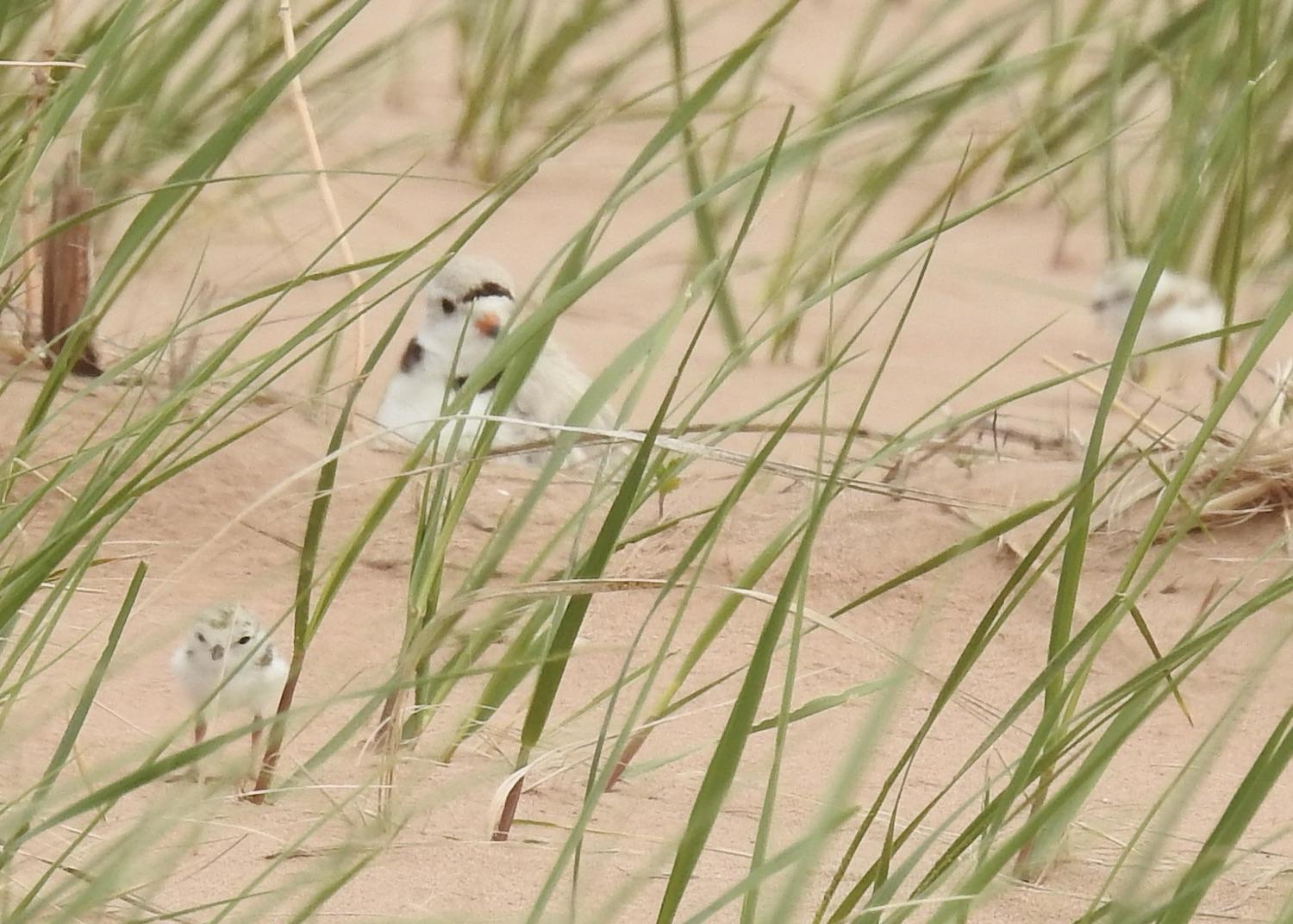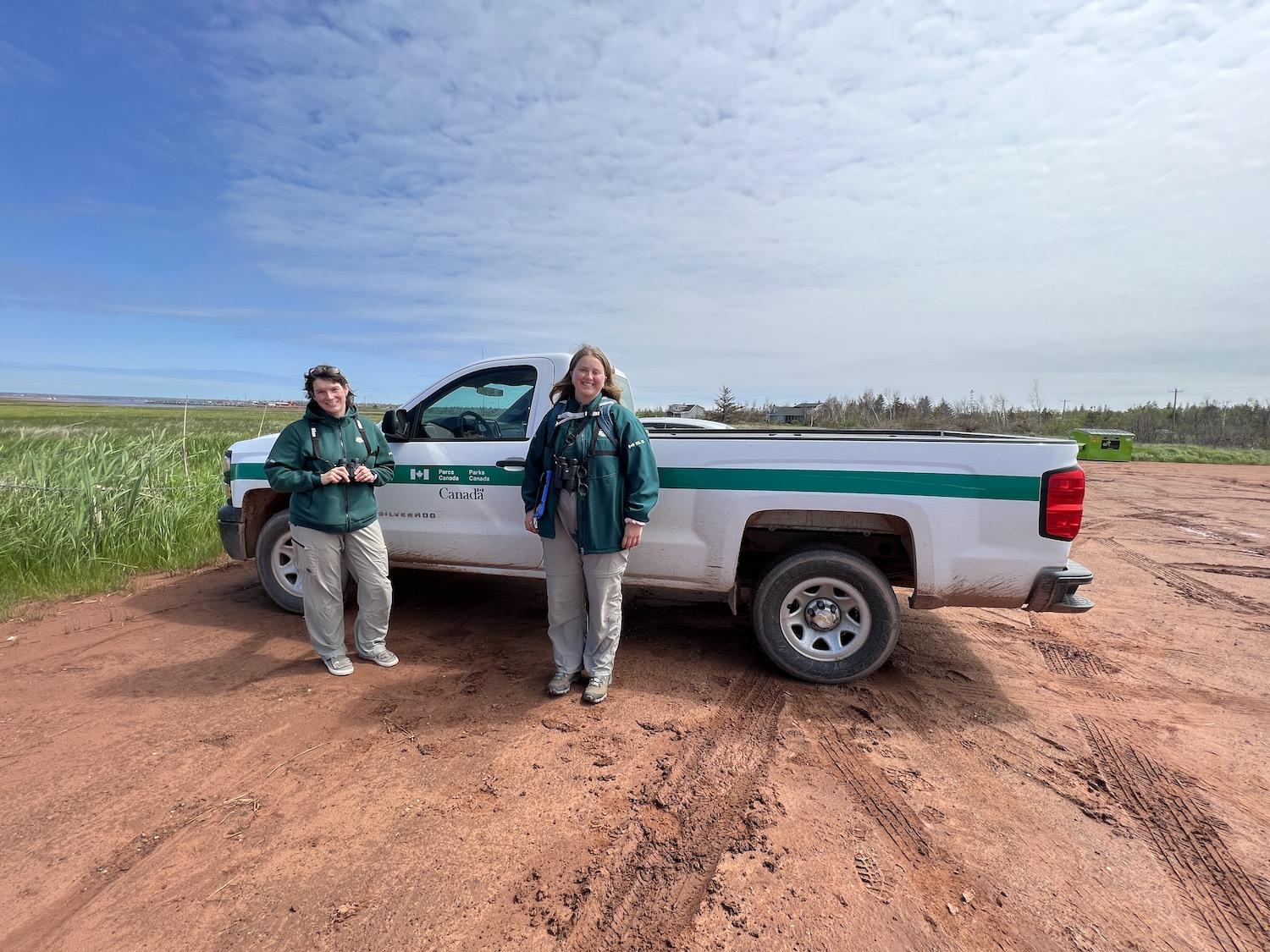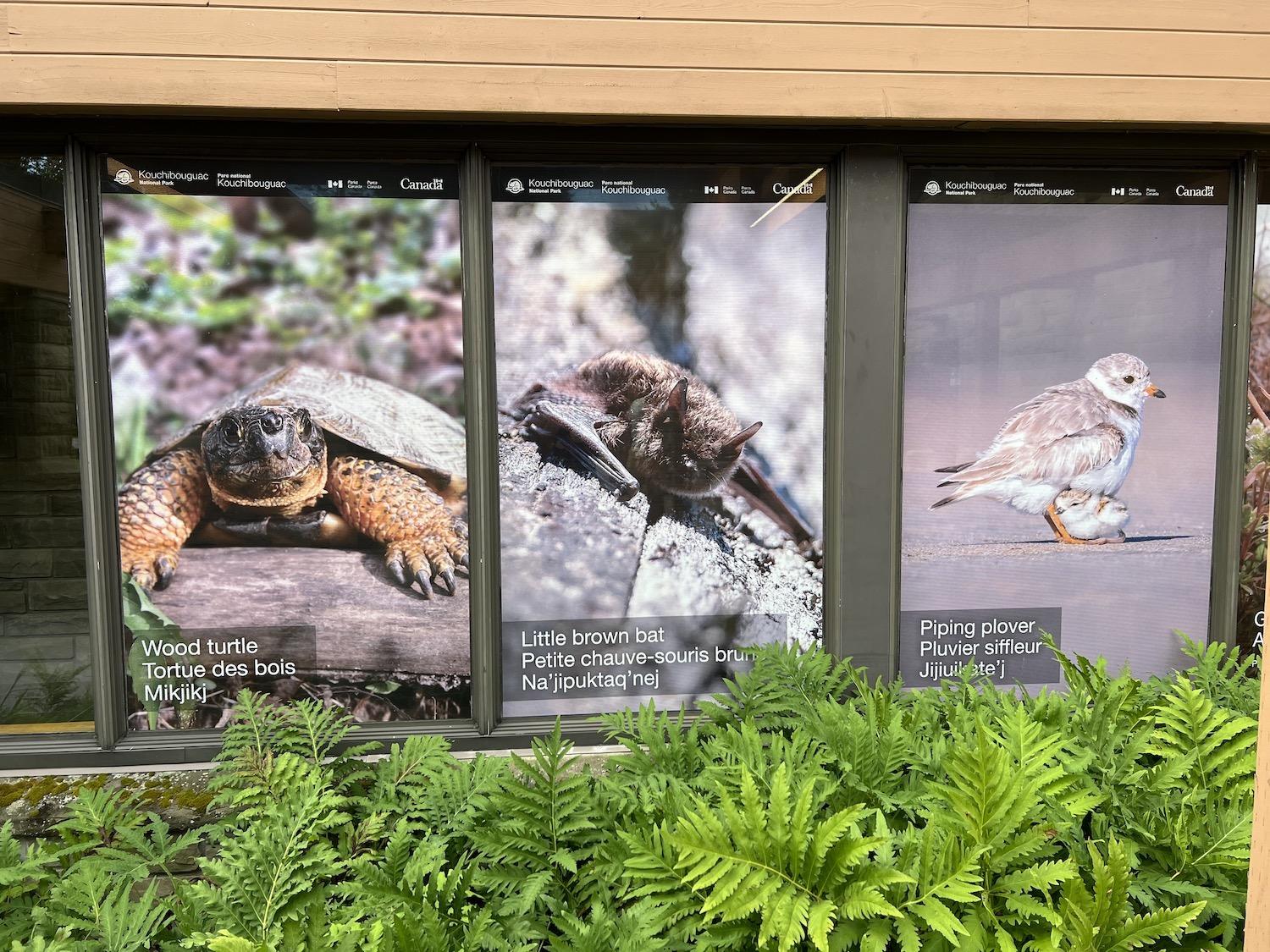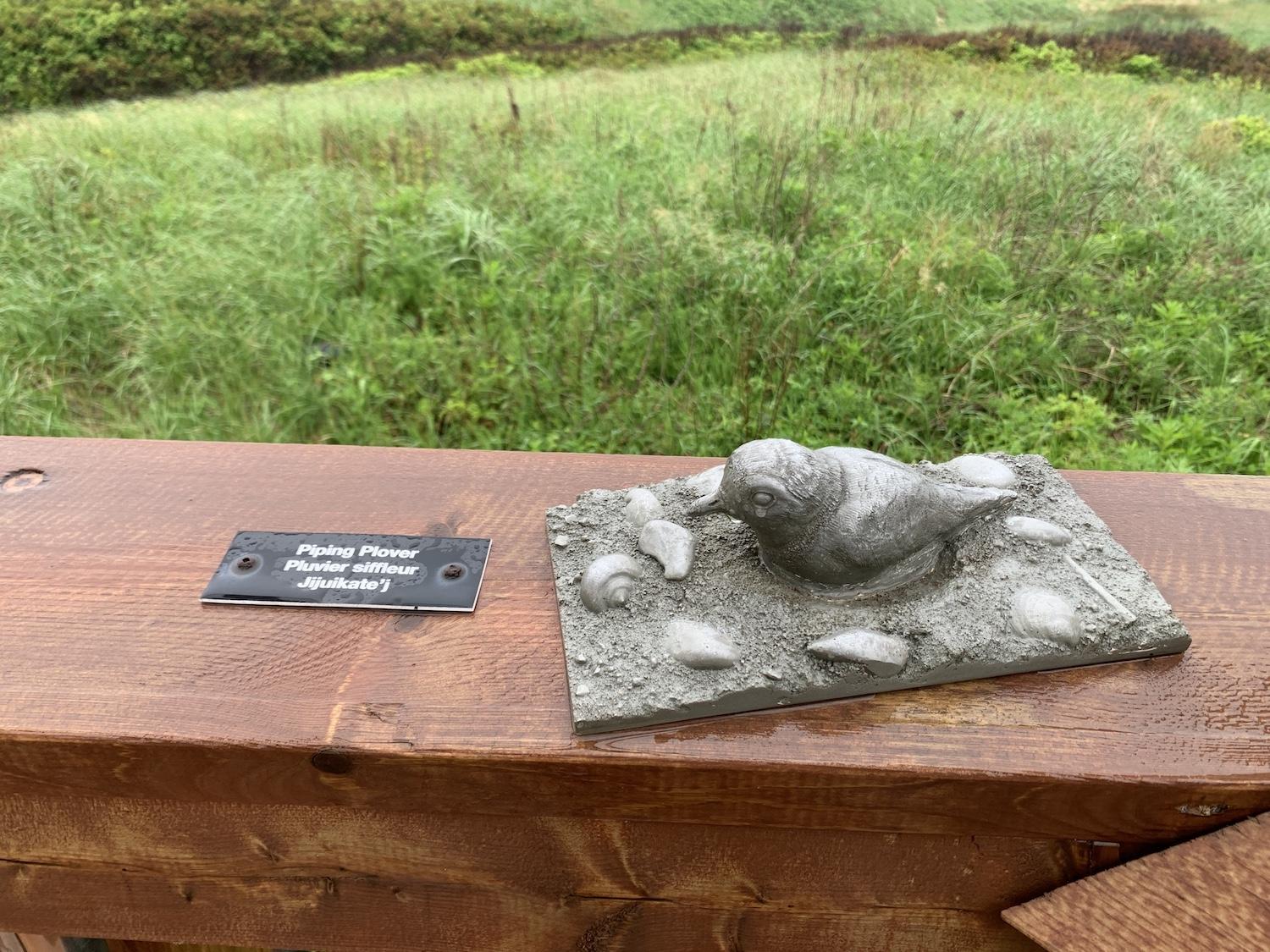
A Piping Plover keeps a watchful eye on two chicks exploring the sandy beach in Prince Edward Island National Park/Lily McLaine, Parks Canada
Just a handful of days old, the Piping Plovers looked like cotton balls on toothpicks as they merrily darted around the foredune exploring the marram grass in the June sun. They were going at full tilt, though, so it was tough to get a good look with binoculars and even harder to capture a decent photograph.
But it was a different story with their parents, who sat and stood not far from each other watching over the brood, occasionally emitting distinctive “peep-lo” calls. One was easy to find near an empty glass bottle. The other hopped on a small mound before getting restless and disappearing from view.
We were in a restricted area within Prince Edward Island National Park so Parks Canada resource management officer Lily McLaine could check on the migratory shorebird (Charadrius melodus melodus) that has been listed as endangered by the Committee on the Status of Wildlife in Canada (COSEWIC) since 1985 and is federeally protected under the Species at Risk Act (SARA).
“We do active weekly monitoring because this is their breeding habitat,” McLaine explained. “The closure helps reduce disturbances for better breeding success. It’s to give them a safe space.”

Parks Canada resource management officer Lily McLain fills out digital details about a Piping Plover nest in Prince Edward Island National Park/Jennifer Bain
The biology graduate — who specializes in species at risk and coastal ecosystems — filled out a digital field sheet, noting that it was June 20, between 2 and 2:30 p.m., on an overcast day about eight hours after high tide. The Beaufort Wind Scale was a level two with a light breeze and small wavelets in the North Atlantic Ocean. There were two adults and four chicks. None wore leg bands and there was no sign of any predators. It was 13C or 55F, which felt warmer than it sounds now.
Plovers are round and stocky birds that are slightly bigger than sparrows. They’re sandy, grayish brown with short, stubby bills, yellow-orange legs, round heads and large dark eyes that give them “a big-eyed look,” as AllAboutBirds.org so vividly describes it. If you've never seen them, it's because they’re nearly invisible as they forage in the higher part of the shoreline and mudflats.
Plovers come to eastern Canada from the United States and Caribbean every spring to nest on sandy beaches and so this national park, famous for its sand dunes, is considered a sanctuary. “The Piping Plover, with its musical call and quick movements, is a lively reminder of our coastline’s fragile beauty,” Parks Canada explains on its website, adding that “Piping Plover chicks can run and forage for food within just a few hours of hatching.”

One of the nesting Piping Plovers photographed with a zoom lens on June 20/Lily McLaine, Parks Canada
The plover is endangered because it has a limited time to mate and find a safe place to breed. Nests are shallow depressions in sandy or pebbly substrate, often lined with small stones and seashell bits. Birds typically lay four eggs, which are tan with black speckles. Eggs hatch after about 28 days, and both parents incubate eggs and tend the chicks. If all goes well, the chicks can fly within 18 to 35 days.
Parks Canada has been working to recover plover populations here since 1982. Each spring, staff identify how many plovers are in the park, where they are and how they’re behaving. Then they watch for nests, signs of hatching, chicks and evidence of fledging. Visitors are asked to do their part. Dogs and other domestic animals (like horses and cats) are banned from all beaches from Apr. 1 to Oct. 15. When plovers are present and breeding, a section of beach around them is closed.
The park is spread out over three locations across the northern shore of Prince Edward Island. On the day that I visited, there were plover closures in all three spots — Greenwich, Cavendish-North Rustico and Brackley-Dalvay. That "beach closures for Piping Plover" information is updated on the "visitor guidelines" of the park's website, right above a section on sand dune regulations.

Parks Canada's Stacey Evans and Lily McLaine are shown in Prince Edward Island National Park near a protected Piping Plover nesting area/Jennifer Bain
McLaine and Stacey Evans — a Parks Canada partnering, engagement and communications officer — took me to a plover nest near Grand Tracadie Beach. This area within Brackley-Dalvay isn’t detailed on parks maps and it butts up against the construction of a boutique resort called Blackbush and its casual seafood restaurant FiN Folk Food.
There wasn’t a rope fence, like the kind in place for some dune closures. But there was a row with bilingual warning signs splayed out on the beach.
“Attention. Area Closed. Endangered Species: Active Piping Plover nesting area. Minimum fine $150,” said one with a sketch of a plover. A second sign showed a walking stick figure in a circle with a red line through it. Another detailed how disturbances by people and their pets can reduce the plovers’ chances of survival, interrupt critical feeding behavior and cause parents to abandon eggs and chicks.

Parks Canada uses a variety of bilingual signs to warn people about Piping Plover beach closures/Jennifer Bain
Locals are certainly well-versed in plover protection, and most visitors respect closures. But I wondered if the lack of a physical barrier was too subtle for foreign travelers (the Japanese gravitate to PEI because it’s the birthplace of the Anne of Green Gables book series, and Parks Canada runs Green Gables Heritage Place in nearby Cavendish to celebrate the author Lucy Maud Montgomery and her fictional character Anne Shirley).
Last October, a local man pleaded guilty in provincial court to entering a beach area that was closed to protect plovers. He had biked into the area, downed a beer and discarded the empty can. He was fined $500 ($380 USD). In 2021, news report outlined how people erected a tent on a dune, lit a bonfire and removed warning signs to use as goal posts for a game. (It’s unclear whether charges were laid.)
While enforcement officers do issue fines, the federal agency focus is on spreading the word about species at risk through public education, local media, travel media and promotional information that finds its way to visitor centers. It admittedly gets confusing when there are different rules for privately owned coastal areas alongside spots run by the province and those, like this, that are federally protected.

Dogs and other domestic animals are banned from PEI National Park beaches during Piping Plover nesting season/Jennifer Bain
“There’s always an education piece that needs to happen there and we hope that when people know better then they can do better,” explained Evans. “With education, the visitors tend to be pretty respectful, because there are such small slivers that are undeveloped that are these areas that species at risk can live and thrive in.”
McLaine and other resource conservation team members often run into passionate locals while doing plover surveys on the beach. “They’re always saying ‘How are the plovers doing?’ and they’re very respectful," she said. "Sometimes visitors are really excited to tell you that they saw somebody, you know, that was walking down by the low tide and walked into the closure and they would tell them about the plovers and show them the sign and they would say `Oh my gosh, sorry.’”
Human activities on beaches threaten, disturb or harm adults, chicks and eggs. This includes walking, sunbathing, fishing, unleashed pets, camping, campfires, kite-flying and fireworks. Food scraps and garbage attract predators like gulls, crows and foxes. Extreme weather events can wash their nests away. Climate change and habitat loss are ongoing challenges.

It's tough to spot nesting Piping Plovers in the foredunes and marram grass/Jennifer Bain
If adults spend too much time away from the nest, the eggs will get cold and won’t hatch. If chicks don’t gain enough weight, they may fail to migrate. Plovers live on the beach so they can easily bulk up on marine worms, fly larvae, beetles, crustaceans, mollusks and other small marine invertebrates and their eggs. Chicks learn to crouch motionless in the sand to hide from intruders, while adults will lure predators away from eggs or chicks by pretending to have a broken wing and then flying away.
The park’s 2023 visitor guide asks people to let staff know if they spot a “most wanted” species-at-risk like a plover, post details on iNaturalist.ca (Canada's gateway to a global species data sharing community) or send a free text to a special “Species at Risk Sightings Line.”
I was lucky to tag along with Parks Canada to a restricted nesting area to see plovers for the first time, and was surprised by how hard it was to spot them. I expected them to be congregating by the water like sandpipers. Instead, these birds stick to pairs and family units and hide in the marram grass and intertidal zone between the dunes and the high-water mark.
“It’s really important to be listening because sometimes you’ll hear them before you seem them,” McLaine said. After a few fruitless minutes creeping about, studying faint footprints in the sand, Evans and I stood still and let McLaine find the family with four, three-day-old chicks that she had already been monitoring. We watched the birds quietly for a few precious moments before McLaine called it quits because one or both parents were starting to get agitated: “Because it’s peeping so much, I think we’ll have to step back.”

Piping Plovers are endangered migratory shorebirds that are protected in Canada and in Prince Edward Island National Park/Jennifer Bain
The number of plover pairs in the park has been declining for 35 years. And while there has been an increase in productivity, plovers are still below their threshold for the number of breeding pairs and productivity. Parks Canada is working with universities and other agencies to better understand the cause of the decline. Outside the park, the Island Nature Trust monitors plovers.
Plovers usually lay four eggs and may “re-nest” if the first one fails. Last year, the park recorded 15 nesting pairs, 17 nests and 51 eggs. Twenty chicks hatched and fully fledged. The fledge rate was “quite high,” according to McLaine, at 1.33 versus 0.67 in 2021. But the annual goal is 15 nesting pairs and a fledge rate of 1.65. As of June 20, the park had recorded 21 adults, with 10 pairs and one single bird. It was monitoring five nests and two hatched nests with eight chicks.
Some speculate that when post-tropical storm Fiona ravaged the park last September, it actually created more of the cobble beach that plovers love for nesting. “It’s hard to tell yet because the season is not complete,” McLaine cautioned, noting storm surges and 2019’s Hurricane Dorian have also contributed to localized habitat change. “But it will be exciting to see at the end of the season.”

A Piping Plover poem written for a species-at-risk art contest in 2022 and displayed at PEI National Park's Greenwich Interpretation Centre/Jennifer Bai-
I always wonder what people notice when they come to a national park like this. Do they see dune and plover closures and just feel annoyed that their beach time has been disrupted, or do they absorb the message, become inspired to dig deeper and then become champions for the cause?
Last year, on a visit to the Greenwich Interpretation Centre in another section of the park, I stood and read all about how life is a constant challenge for the internationally endangered plovers who find sanctuary here.
There was also a poem posted on the wall that had taken third place in what must have been a species-at-risk art contest for local schoolkids. "Piping Plovers are in need/helping out is nice indeed," wrote Maggie Costain. "Here's how you can make a change/don't walk your dog near their range/do not wander near their home/find somewhere else to roam." Five sentences and this young girl nailed it. "They do not have a voice/so here we are with a choice/we can change if we try/do not let this species die."

You'll walk by massive photo panels of plovers and other species-at-risk at Kouchibouguac National Park's visitor reception center in New Brunswick/Jennifer Bain
I told McLaine and Evans that I had just been to Kouchibouguac National Park in New Brunswick, where they hand out free species-at-risk postcards showcasing the plovers, have huge species-at-risk photo panels outside the visitor reception center entrance. Like PEI National Park, they ban dogs from going on the dunes and use seasonal closures to protect nesting birds.
Plover messaging, however, is also aimed at children. There was a model of an oversized plover egg that's cracked open to reveal a maze so kids can help a baby plover bypass predators and find safety. There was also a puzzle block game that can be arranged to show a chick, fledgling or adult bird, and the chance to create a rubbing and then made a pledge to become a plover protector. The surface of a cafe-style table was cleverly plastered with a photo message that shows two a boy and girl building a sandcastle along four smaller images of plover eggs, plover chicks, a fledgling and an adult.
"The sun shines for one and all," reads the pointed message. "Let's share the beach with the Piping Plover."

Inside the Kouchibouguac National Park visitor reception center, Piping Plover messaging is aimed at kids/Jennifer Bain
A few days after my baby plover encounter in PEI National Park, I spent a night at Shaw’s Hotel & Cottages, a family-owned resort that has existed on the park's edge since 1860 and has even been designated a national historic site for its role in early tourism in the province.
I was up early doing a section of the Island Walk — a pilgrimage-style, long-distance walk like Spain’s Camino de Santiago. Created by retiree Bryson Guptill, it circumnavigates PEI with 32 day-long sections that follow secondary highways, red dirt country roads, the Confederation Trail and beaches. This section follows Gulf Shore Way, a paved cycling trail beside Gulf Shore Parkway through the park. When I ducked down to popular Brackley Beach, I spotted more elaborate warning signs for plover nesting areas. These showed adorable photos of plovers and similar species, plus gently asked people to watch for hidden nests, stay out of closed areas, keep dogs off the beach and pick up garbage.
I saw two woman walk to the closure area and immediately turn back. But back on the cycling trail, I spotted someone poking around a protected area just off the road near a marshy area by Covehead Lighthouse. Luckily, it was just Lindsey Burke, another resource management officer, who sadly revealed that a plover nest has just been lost. “I didn’t see any predator tracks leading up to it and the nest cup was still there,” she said. “The pair were still there. Actually, when I went down, they were both walking around feeding and that’s not a good sign because usually one would be incubating. The birds flew off and there was nothing more she could do.
“Not the best start to the day,” admitted Burke, who had been poised to set up a nest cam. “I’ll check this nest in a few days and see if they’re still here. They might re-nest.” With that, she hopped in her car and drove off to check on another plover nesting site, hopeful that everything would be well with the endangered birds.

In June 2022, I found this Piping Plover art piece in the Cavendish area of PEI National Park alongside signage welcoming visitors to the endangered shorebird's home/Jennifer Bain

 Support Essential Coverage of Essential Places
Support Essential Coverage of Essential Places



